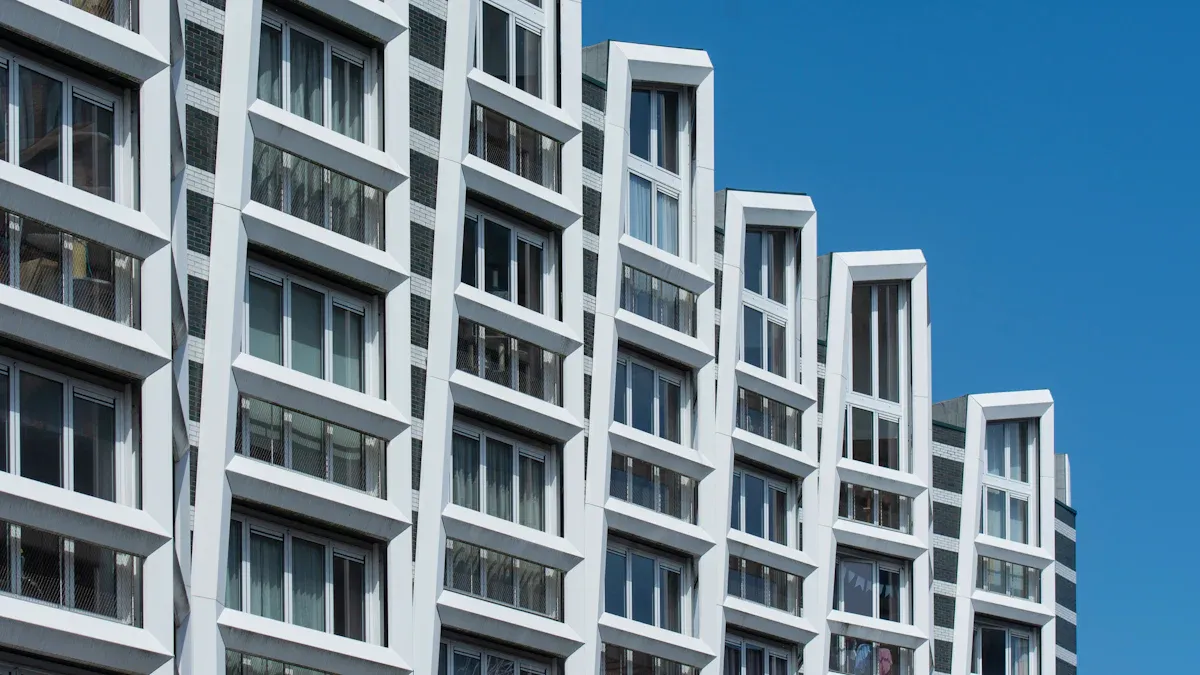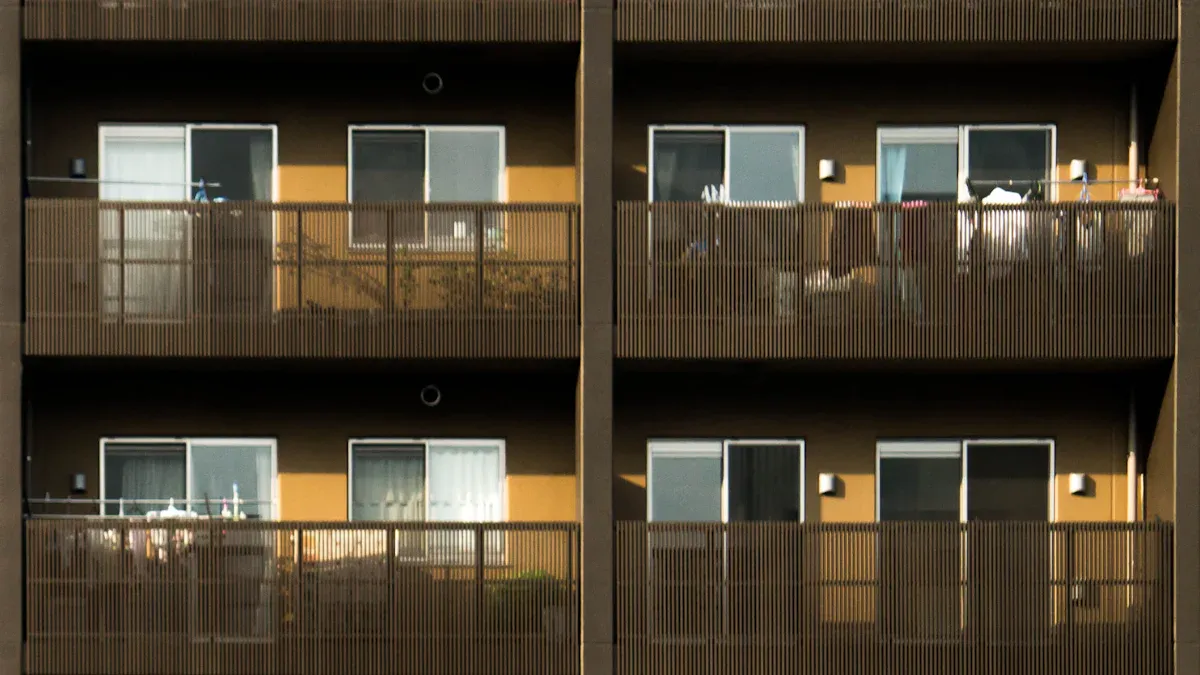HUD and FHA Announce New Multifamily Program Updates for 2025

You now have more opportunities to address the housing crisis, thanks to HUD and FHA Multifamily Housing Program Updates for 2025. These changes aim to make financing more accessible and encourage the development of affordable rental homes. For example, the FHA has lowered the debt service coverage ratio (DSCR) from 1.15 to 1.11 for properties with low-income housing tax credits. It has also raised the loan-to-value ratio to 90%, making it easier for developers to secure funding.
Additionally, HUD has increased its per-unit lending limits by 3.4% from 2024. Here are the new limits for the 221(d)4 program:
0 Bedrooms: $66,864 (Non-elevator), $72,228 (Elevator)
1 Bedroom: $75,904 (Non-elevator), $82,802 (Elevator)
2 Bedrooms: $91,749 (Non-elevator), $100,689 (Elevator)
3 Bedrooms: $115,254 (Non-elevator), $130,257 (Elevator)
4+ Bedrooms: $130,129 (Non-elevator), $142,986 (Elevator)
These updates reflect a commitment to expanding housing supply and improving affordability for families across income levels.
Key Takeaways
HUD and FHA lowered the DSCR to 1.11. This helps developers get loans with less income.
New rules for middle-income housing support mixed-income neighborhoods. These rules encourage economic diversity and inclusion.
A new loan type for middle-income rentals offers special financing. This helps developers serve families in need.
Higher per-unit loan limits and loan-to-value ratios give more funding. This supports building affordable homes.
Knowing Qualified Contract rules is key to keeping low-cost housing affordable for a long time.
Key HUD and FHA Multifamily Housing Program Updates

Adjustments to DSCR and LTV/LTC Ratios
You will notice significant changes to the debt service coverage ratio (DSCR) and loan-to-value/loan-to-cost (LTV/LTC) ratios in the latest HUD and FHA Multifamily Housing Program Updates. These adjustments aim to make financing more accessible for developers while maintaining a balance between risk and reward for lenders. Lower DSCR requirements mean you can qualify for loans with less income relative to debt obligations. For example, the FHA has reduced the DSCR for properties with low-income housing tax credits to 1.11, down from 1.15. This change allows you to secure financing even if your property generates slightly lower income.
Revised LTV/LTC ratios also play a crucial role. By increasing the maximum loan amount relative to the property value or cost, these updates make it easier for you to fund your projects. HUD has updated FHA guidelines to allow higher LTV/LTC ratios, enhancing the feasibility of financing.
Here’s how these adjustments impact project financing:
Interest Rate Change | Required Rent Increase to Maintain DSCR | LTV Ratio | DSCR Level |
|---|---|---|---|
+50 bps | +5% | 70% | 1.0 |
Mortgage Rate 5.5% | $2,250 | 70% | 1.0 |
After 300 bps Increase | $2,810 (25% increase) | 70% | 1.0 |
These changes reflect HUD’s commitment to improving financing flexibility, ensuring that more developers can participate in creating affordable housing.
Introduction of Middle-Income Housing Standards
HUD and FHA have introduced new middle-income housing standards to address the growing need for affordable rental options for families earning up to 120% of the area median income (AMI). These standards encourage you to develop mixed-income communities, which combine affordable and market-rate units. By doing so, you can create neighborhoods that promote economic diversity and reduce housing segregation.
The middle-income housing standards also provide clear underwriting guidelines, making it easier for you to plan and execute projects. For example, these standards prioritize developments that include a mix of income levels, ensuring that middle-income families have access to quality housing without being priced out of the market. This initiative aligns with HUD’s broader goal of expanding housing supply and fostering inclusive communities.
New Mortgage Category for Middle-Income Rental Properties
To further support middle-income families, HUD has introduced a new mortgage category specifically for rental properties where at least 50% of the units are designated for middle-income households. This category provides you with tailored financing options, making it easier to develop properties that cater to this underserved segment of the population.
This new mortgage category builds on recent trends in HUD and FHA updates. For instance, the FHA recently increased loan limits for multi-section and single-section homes under the Title I program. These changes, which had not been updated since 2009, reflect the rising cost of housing over the past decade. By increasing loan limits by $125,000 for multi-section homes and over $35,000 for single-section homes, the FHA has improved access for tens of thousands of families. Annual updates to these limits will ensure they keep pace with housing prices, providing you with consistent support for your projects.
With these updates, you can take advantage of new opportunities to address the housing needs of middle-income families while contributing to the development of sustainable and inclusive communities.
Guidance on Qualified Contract (QC) Provisions in LIHTC Program
The Qualified Contract (QC) provision in the Low-Income Housing Tax Credit (LIHTC) program plays a crucial role in ensuring long-term affordability for low-income housing properties. As a developer or property owner, understanding these provisions can help you navigate the compliance period and maintain affordability standards.
The QC provision allows property owners to exit the LIHTC program after the initial 15-year compliance period. However, this process comes with specific requirements to protect the affordability of the housing units. If you decide to sell your property, you must first offer it to a qualified buyer at a price determined by the QC formula. This ensures that the property remains affordable for low-income families.
Here’s a breakdown of the key regulations governing the QC provision:
Section | Description |
|---|---|
Defines a qualified contract as a bona fide contract to acquire the non low-income portion of the building for fair market value and the low-income portion for an amount not less than the applicable fraction of specified sums. | |
42(h)(6)(F) | Allows the Secretary to prescribe necessary regulations to prevent manipulation of the purchase price determination. |
42(h)(6)(I) | Mandates that the Agency must present the qualified contract within one year after the owner's request post the 14th year of the compliance period. |
1.42-18(c)(1) | Defines the formula for computing the purchase price of the low-income housing building. |
1.42-18(c)(2) | Specifies the low-income portion amount calculation based on outstanding indebtedness, adjusted investor equity, and other capital contributions. |
These regulations ensure that the QC process remains transparent and fair. For example, the formula for determining the purchase price considers factors like outstanding debt and investor equity. This prevents inflated pricing and ensures that the property remains accessible to low-income families.
If you’re a developer, the QC provision offers a structured pathway to transition out of the LIHTC program while preserving affordability. For state housing finance agencies, these guidelines provide a framework to evaluate and approve qualified contracts. By adhering to these provisions, you contribute to the broader goals of the HUD and FHA Multifamily Housing Program Updates, which aim to expand housing supply and support affordability.
Tip: Familiarize yourself with the QC formula and timelines to ensure compliance. Missing deadlines or miscalculating the purchase price can delay the process and impact your project’s financial outcomes.
The QC provision reflects a balance between the interests of property owners and the need for long-term affordable housing. By following these guidelines, you can align your projects with federal housing goals and make a meaningful impact on your community.
Goals and Expected Impact

Expanding Housing Supply
The updated HUD and FHA Multifamily Housing Program Updates aim to significantly increase the availability of housing across the country. These changes provide developers with more financing options, making it easier for you to build new homes and renovate existing properties. By reducing barriers to funding, these updates encourage the creation of housing units that meet the needs of diverse communities.
Several initiatives highlight the potential for growth in housing supply. For example:
Updated guidance for the American Rescue Plan’s State and Local Fiscal Recovery Funds now supports affordable housing construction.
Clarifications to the Emergency Rental Assistance program allow broader use of funds for affordable housing projects.
Financing support for a risk-sharing initiative has been extended, lowering the costs of creating and preserving affordable housing.
Here’s a snapshot of projected housing expansions in key locations:
Location | Initiative Description | Projected Units |
|---|---|---|
New York City | Plan to build new homes over the next 15 years | 100,000 |
Los Angeles | Approval for development of additional units in downtown and Hollywood areas | 135,000 |
Hawaii | Executive order to ease laws for construction of homes across all income brackets | Thousands |
California | Senate Bill 406 to fast-track affordable housing projects | N/A |
Minneapolis | Comprehensive plan to boost affordable housing production | N/A |
These efforts demonstrate a nationwide commitment to addressing the housing shortage. By leveraging these updates, you can play a vital role in expanding the housing supply and meeting the growing demand for affordable homes.
Supporting Affordability for Low- and Middle-Income Families
The program updates prioritize affordability for families with low and middle incomes. You can now access financing options tailored to projects that serve households earning up to 120% of the area median income (AMI). This focus ensures that more families can find homes within their budgets, reducing the financial strain caused by rising housing costs.
For low-income families, the updates align with the Low-Income Housing Tax Credit (LIHTC) program to preserve affordability. New guidance on Qualified Contract provisions ensures that properties remain affordable beyond the initial compliance period. For middle-income families, the introduction of a new mortgage category supports the development of rental properties where at least half of the units are reserved for this income group. These changes create opportunities for you to develop projects that cater to a broader range of income levels.
Note: By focusing on affordability, these updates help bridge the gap between housing costs and household incomes, making it easier for families to thrive.
Promoting Mixed-Income Communities
The updates also encourage the development of mixed-income communities. These neighborhoods combine affordable and market-rate housing, fostering economic diversity and reducing segregation. By creating spaces where families from different income levels can live together, you contribute to more inclusive and vibrant communities.
The new middle-income housing standards provide clear guidelines for developing mixed-income projects. These standards prioritize developments that include a mix of income levels, ensuring that middle-income families have access to quality housing. This approach aligns with HUD’s broader goals of promoting social equity and expanding housing opportunities.
Mixed-income communities offer several benefits:
They reduce economic disparities by integrating families from various income brackets.
They promote access to shared resources, such as schools and public services.
They create a sense of belonging and community for residents.
By adopting these standards, you can help build neighborhoods that reflect the diversity of the population and provide opportunities for all families to succeed.
Alignment with Biden-Harris Administration Housing Goals
The 2025 HUD and FHA multifamily housing updates align closely with the Biden-Harris administration's housing goals. These updates reflect a shared commitment to expanding housing supply, improving affordability, and fostering sustainable communities. By leveraging these changes, you can contribute to a broader national effort to address housing challenges.
The administration has prioritized housing as a cornerstone of its agenda. Several initiatives highlight this focus:
The Building Performance Standards Coalition, launched by the administration, includes 33 state and local governments. This coalition aims to retrofit four million buildings and two million homes, enhancing energy efficiency and supporting affordable housing goals.
HUD has already built or repaired over 500,000 affordable housing units. In 2022 alone, nearly 1.7 million new housing units were constructed.
To further boost housing production, the administration awarded $85 million in PRO Housing funding and announced an additional $100 million for future projects.
These efforts demonstrate a clear alignment with the multifamily program updates. For example, the introduction of middle-income housing standards supports the administration's goal of creating inclusive communities. By developing mixed-income neighborhoods, you can help reduce economic disparities and promote social equity.
The administration has also made historic investments in underserved communities. These include expanding rental assistance and improving homeownership accessibility. Tribal and Latino communities have benefited significantly from these initiatives, which aim to enhance housing opportunities for all. The HUD and FHA updates complement these efforts by providing more financing options for developers like you, ensuring that housing remains affordable and accessible.
Tip: Consider how your projects can align with these federal goals. By focusing on energy efficiency, affordability, and inclusivity, you can maximize the impact of your developments.
The alignment between the multifamily program updates and the administration's housing goals creates a unique opportunity for you to make a difference. Whether you're a developer, lender, or investor, these changes provide the tools you need to contribute to a more sustainable and equitable housing market.
Stakeholder Implications

Opportunities for Developers
The 2025 HUD and FHA updates open new doors for you as a developer. These changes make financing more accessible, allowing you to take on projects that might have been out of reach before. With lower debt service coverage ratios (DSCR) and higher loan-to-value (LTV) ratios, you can secure funding with less income and invest more in your developments. This flexibility helps you build affordable housing while maintaining profitability.
The introduction of middle-income housing standards also creates opportunities for you to develop mixed-income communities. These projects not only address housing shortages but also foster economic diversity. By including units for families earning up to 120% of the area median income, you can attract a broader range of tenants and create sustainable neighborhoods.
Tip: Explore the new mortgage category for middle-income rental properties. It offers tailored financing options that can make your projects more viable.
Benefits for Lenders and Investors
The updated programs also benefit lenders and investors by improving loan performance and reducing risks. Multifamily loans under these updates show strong performance metrics, making them attractive investment options. For example:
Report Type | Description |
|---|---|
Insights into loan performance metrics, highlighting benefits for lenders. | |
Monthly Summary | Trends in multifamily loan performance, useful for investment decisions. |
Capital Disclosures | Details on capital management and risk, ensuring financial health. |
Additionally, resources like the Commercial/Multifamily Research and the 2024 Loan Maturity Report provide valuable data for assessing market opportunities. These tools help you make informed decisions and maximize returns.
Encouragement for State Housing Finance Agencies (HFAs)
State Housing Finance Agencies (HFAs) gain significant support through these updates. HUD now offers enhanced technical assistance, including webinars and online courses, to help you navigate funding opportunities. The department also provides updated datasets for public analysis, enabling you to better understand housing trends and needs.
Evidence Type | Description |
|---|---|
Data Assets | |
Technical Assistance | Webinars and courses for funding recipients. |
Standards for Success | Extended data collection framework for better service coordination. |
These resources empower you to implement housing programs more effectively. By leveraging these tools, you can expand affordable housing options and meet the needs of underserved communities.
Impacts on Rural and Low-Income Markets
The 2025 HUD and FHA program updates bring significant benefits to rural and low-income housing markets. These areas often face unique challenges, such as limited housing stock and fewer financing options. With the new changes, you can expect improved access to funding and expanded opportunities to develop affordable housing in underserved regions.
Section 8 housing plays a critical role in supporting families in these markets. Millions of households rely on this program to find affordable homes. Recent trends highlight important shifts that influence housing availability and affordability:
Section 8 housing now supports a more diverse group of families across the country.
Urban areas are experiencing growth in Section 8 housing, while rural regions face distinct challenges.
Migration patterns are reshaping the distribution of Section 8 housing, increasing demand in high-growth areas.
These changes are putting pressure on housing markets in popular locations, making affordability a key concern.
The program updates address these issues by offering tailored financing options for rural developers. For example, higher loan-to-value ratios and lower debt service coverage requirements make it easier for you to secure funding. These changes encourage the construction of affordable homes in areas where they are needed most.
You can also benefit from new guidance on long-term affordability. This ensures that properties remain accessible to low-income families, even after the initial compliance period. By leveraging these updates, you contribute to reducing housing disparities and creating sustainable communities in rural and low-income markets.
Tip: Focus on understanding local housing needs. This helps you align your projects with the specific challenges and opportunities in these areas.
Industry Feedback

Positive Reception from Mortgage Bankers Association
The Mortgage Bankers Association (MBA) has expressed strong support for the 2025 HUD and FHA multifamily program updates. These changes align with the MBA’s goals of expanding housing supply and improving financing options for developers. You can see this enthusiasm reflected in their public statements, which highlight the potential for these updates to drive significant growth in affordable housing.
The MBA has also emphasized how the adjustments to DSCR and LTV ratios make FHA loans more competitive. This competitiveness encourages more developers to participate in affordable housing projects. By simplifying financing requirements, the updates reduce barriers for you and other stakeholders, making it easier to bring projects to life.
Note: The MBA’s endorsement signals confidence in the updates’ ability to address housing challenges effectively.
Perspectives from Developers and Investors
Developers and investors have welcomed the multifamily program updates as a game-changer for the housing market. These updates provide you with new opportunities to secure funding and expand your projects. Many industry leaders have already seen positive results from similar initiatives.
Qualified opportunity funds have raised over $40 billion, supporting nearly 200,000 housing units, most of which are multifamily properties.
Ben Glasner from the Economic Innovation Group noted a "large — and still rising — increase in housing supply" due to opportunity zones.
Cityview successfully expanded its investor base, showing the program’s appeal to wealthy individuals and family offices.
Gancman highlighted the program’s success in meeting public policy goals, despite minor flaws.
These examples demonstrate how the updates can help you attract investors and achieve your development goals.
Anticipated Increase in Affordable Rental Units
The program updates are expected to significantly boost the availability of affordable rental units. By lowering financing barriers, these changes enable you to develop properties that cater to low- and middle-income families. This expansion addresses the growing demand for affordable housing across the country.
Experts predict that these updates will lead to a surge in new housing developments. For example, the introduction of middle-income housing standards encourages the creation of mixed-income communities. These neighborhoods provide affordable options while fostering economic diversity. As a result, you can expect to see more inclusive and sustainable housing solutions in the coming years.
Tip: Focus on leveraging these updates to maximize your impact on the affordable housing market.
Expert Insights on Policy Synergies
The 2025 HUD and FHA multifamily housing updates demonstrate how well-designed policies can work together to create greater impact. Experts emphasize that consolidating overlapping regulations can simplify compliance for developers like you. For instance, New York City’s Local Laws 97 and 87 provide a model for streamlining requirements. By reducing redundancies, you can focus more on building affordable housing and less on navigating complex rules.
Simplifying application processes also plays a key role in improving program efficiency. The Affordable Housing Streamlining Ordinance in Los Angeles serves as a great example. This ordinance has shown how cutting down on bureaucratic hurdles can help you access funding faster, enabling quicker project completion. When programs are easier to navigate, you can allocate more resources to construction and development.
Coordination among federal agencies is another area where experts see potential for synergy. Better communication and knowledge sharing between agencies can enhance the effectiveness of housing programs. This approach ensures that you receive consistent guidance and support throughout your projects.
Collaboration with other sectors, such as healthcare and transportation, can amplify the benefits of housing initiatives. For example, integrating decarbonization efforts with housing development can improve energy efficiency while reducing costs. Programs like NYSERDA’s Multifamily Performance Program show how phased incentive payouts can help small property owners finance green upgrades. These strategies not only benefit the environment but also make housing more affordable for families.
By leveraging these insights, you can align your projects with best practices and maximize their impact. Streamlined policies, cross-sector collaboration, and phased incentives create a foundation for sustainable and inclusive housing solutions.
The 2025 HUD and FHA multifamily housing updates represent a significant step forward in solving housing challenges. These changes empower you to address affordability, expand housing supply, and create mixed-income communities. Programs like Permanent Supportive Housing (PSH) have already shown success by improving health outcomes and reducing costs, though research gaps remain.
Tip: Use these updates to develop sustainable housing solutions that benefit diverse communities. By taking action now, you contribute to a more inclusive and equitable housing market for the future.
FAQ
What is the purpose of the 2025 HUD and FHA updates?
The updates aim to expand housing supply, improve affordability, and promote mixed-income communities. They provide developers and lenders with more flexible financing options, making it easier to create affordable housing for low- and middle-income families.
How do the new DSCR and LTV/LTC adjustments benefit developers?
Lower DSCR requirements and higher LTV/LTC ratios make it easier for you to qualify for loans. These changes allow you to secure funding with less income and invest more in your projects, increasing the feasibility of affordable housing developments.
What are middle-income housing standards?
Middle-income housing standards focus on creating rental properties for families earning up to 120% of the area median income. These standards encourage mixed-income communities, combining affordable and market-rate units to promote economic diversity and inclusivity.
How do the updates impact rural housing markets?
The updates improve funding access for rural developers by offering higher loan-to-value ratios and lower debt service coverage requirements. These changes help you address housing shortages in underserved areas, ensuring affordable homes for low-income families.
How can developers align with federal housing goals?
Focus on building energy-efficient, inclusive, and affordable housing. Use the new financing options to create mixed-income communities. By aligning your projects with these goals, you contribute to a sustainable and equitable housing market.
Tip: Stay informed about HUD and FHA resources to maximize the benefits of these updates.
See Also
A Comprehensive Guide to Multifamily Financing for Beginners
Navigating Challenges and Opportunities in Hotel Financing
Understanding the Essentials of Hotel Financing Options

